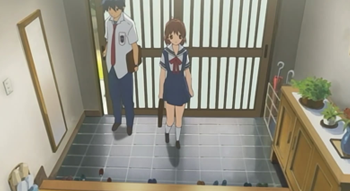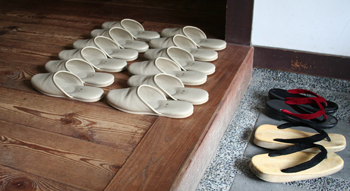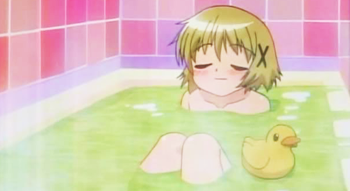Tempest’s Downpour – Anime In-Jokes 5 – Japanese Home Life Edition
In the middle of an anime episode, the young female protagonist finishes up her after school club and intends to walk home, but not before calling out: ”See you tomorrow” to her fellow classmates. They reply using the same greeting with energy.
She arrives home, slides open the door, and calls out to her mom: “I’m home.”
”Welcome home,” her mom replies with the same energy as her classmates.
The protagonist pries off her shoes at the landing and slides on slippers with ease. In the next little while, dinner is ready. She sits on her knees at a low table to a spread of different kinds of food. Before she can eat, she presses her hands together and says to herself: “I humbly receive.”

An anime character returning home
Her mom sits down and does the same before they both eat. After dinner, the protagonist goes to take a bath. She showers first before she goes to soak in the tub, and spends the time contemplating her day as she lets out a sigh of relaxation. At night she unfolds her futon on the floor and goes to sleep.
… What just happened? There are so many little rituals involved in every day home life that it doesn’t feel natural even when translated into English.
Foremost are the greetings. Any school scene involves people shouting hellos or goodbyes to their classmates in frighteningly cheerful tones. That’s not just in the sugar-coated world of anime: Japanese greetings are meant to be said in energetic tones with any interaction.
There are key phrases for meeting someone for the first time, talking to your boss at work, talking to your friends, visiting long-lost relatives or even just arriving home after a shopping trip or at the end of a tiring day. Many of the phrases are based around old religious beliefs.
For example, “itadakimasu” is a way of saying thanks to everything that participated in helping to create the meal, while “gochisosama-deshita” recognizes that a lot of effort was put into the meal that was just enjoyed [1]. Both are said with the namasté hand gesture, which is rooted in Buddhist practices [2].

Anime characters sitting down to a meal, a few of whom are using the namasté gesture
In Japan and some other countries it is considered impolite to wear shoes in houses, schools or other certain establishments. Students swap their shoes for slippers in the locker room while Japanese households are built with a step just after the entranceway to mark the area where shoes are removed.
In an episode of Azumanga Daioh, Osaka horrifies herself and Yukari-sensei at the thought of Americans walking around their houses in shoes with the question: “what if they stepped in dog poop?”

A Japanese hotel with the wooden step and available slippers for guests
Baths are also something completely different than their American counterparts. In Japan, baths aren’t seen as just a way to keep clean, and it is considered very rude to dirty the bath water. All soap should be washed off by a hand-held shower head on a stool before a person relaxes in the tub. Bath time is seen as a way to relax from the stresses of the day and reflect in pure silence and warmth.
Traditional bath tubs in Japan are shorter and deeper than those in America, though Westernization has been an ongoing trend as of late, and longer, shallower tubs are popular. For smaller tubs, the family members take turns in the bath in order of seniority. However with larger tubs, and especially families with young children, it is not unusual for the family to bathe together. Communal bathhouses are still in use and hot springs are treated with similar rules, though both are separated by gender.

An anime character relaxing in the bathtub
Due to Westernization, it is more common to see regular beds in Japanese households – especially in anime. But sometimes when a character is getting ready to sleep, he or she goes to the closet and unfolds a futon. Futons were the preferred method for sleep because they do not take up space, leaving the room open for other uses throughout the day [3].
Futons are thin mattresses that can be made of any material ranging from cotton (the most common) to feather (allegedly the “most comfortable.”) They are accompanied by a pillow and light comforter, as well as a blanket during the colder months.

A traditional futon on tatami flooring
So the next time your protagonist mutters something cheerful to herself or takes an inexplicable bath in the middle of the day and goes to sleep on a mat on the floor, you know the reasons why.
Sources:
[1] http://en.wikipedia.org/wiki/Etiquette_in_Japan
[2] http://en.wikipedia.org/wiki/Namast%C3%A9
[3] http://www.furusato.or.jp/eng/fusyuu/04.html

















waw i had no idea that there were soo many richuals used in dayly life. great explanaitions it was very interesting.
Great article. and gee..I always thought my Japanese friends were just always so happy to see me… Oh and shoes off..a must for every house..yes.
Oh, that’s cool- I always wondered why everyone was so happy in animes, I always sort of envied their cheerfulness.